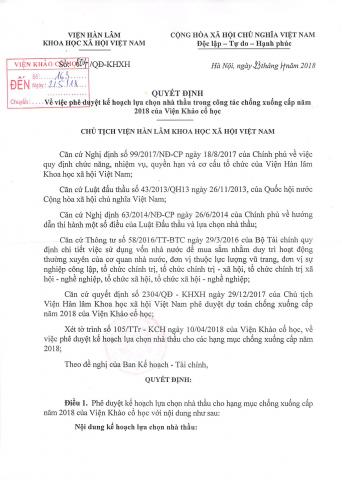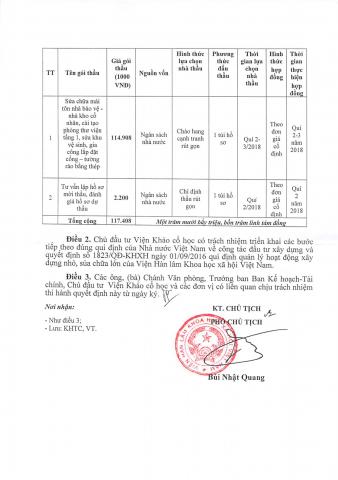- Tác g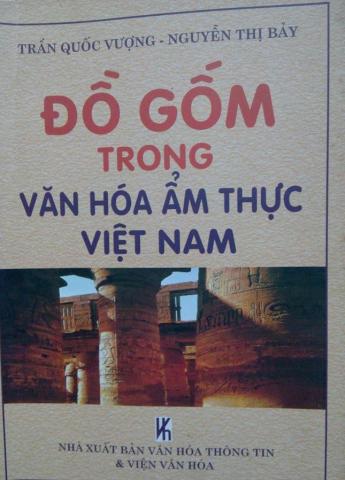 iả: Trần Quốc Vượng, Nguyễn Thị Bảy
iả: Trần Quốc Vượng, Nguyễn Thị Bảy
- Nxb: Văn hóa - Thông tin – 2006
- Khổ sách: 14,5x 20,5cm
- Số trang: 207 trang + phụ lục ảnh
 iả: Trần Quốc Vượng, Nguyễn Thị Bảy
iả: Trần Quốc Vượng, Nguyễn Thị Bảy- Nxb: Văn hóa - Thông tin – 2006
- Khổ sách: 14,5x 20,5cm
- Số trang: 207 trang + phụ lục ảnh
Nội dung cuốn sách: Cuốn sách viết về đồ gốm trong văn hóa ẩm thực của người Việt Nam, bao gồm các chương:
Chương 1: Đại quan về đồ đốm và đồ gốm dùng trong ẩm thực: Trong chương này tác giả định nghĩa đồ gốm là gì, đồ gốm ra đời từ khi nào, đồ gốm được chế tạo bằng gì, làm như thế nào, ai làm ra và đồ gốm để làm gì.
2/ Diễn trình lịch sử đồ gốm và đồ gốm dùng trong ẩm thực Việt Nam - Hà Nội: Nêu một số vấn đề như gốm thời tiền sử và sơ sử, các làng gốm và địa điểm sản xuất gốm 10 thế kỷ đầu công nguyên và văn hóa ẩm thực, các làng gốm từ thế kỷ 11 - 14 với văn hóa ẩm thực, các làng gốm thế kỷ 15 - đầu thế kỷ 20.
Chương 3: Bản sắc và tính trường tồn của gốm sứ - văn hóa ẩm thực Việt Nam.
Chương 1: Đại quan về đồ đốm và đồ gốm dùng trong ẩm thực: Trong chương này tác giả định nghĩa đồ gốm là gì, đồ gốm ra đời từ khi nào, đồ gốm được chế tạo bằng gì, làm như thế nào, ai làm ra và đồ gốm để làm gì.
2/ Diễn trình lịch sử đồ gốm và đồ gốm dùng trong ẩm thực Việt Nam - Hà Nội: Nêu một số vấn đề như gốm thời tiền sử và sơ sử, các làng gốm và địa điểm sản xuất gốm 10 thế kỷ đầu công nguyên và văn hóa ẩm thực, các làng gốm từ thế kỷ 11 - 14 với văn hóa ẩm thực, các làng gốm thế kỷ 15 - đầu thế kỷ 20.
Chương 3: Bản sắc và tính trường tồn của gốm sứ - văn hóa ẩm thực Việt Nam.
Xin trân trọng giới thiệu!
Ngô Thị Nhung
- T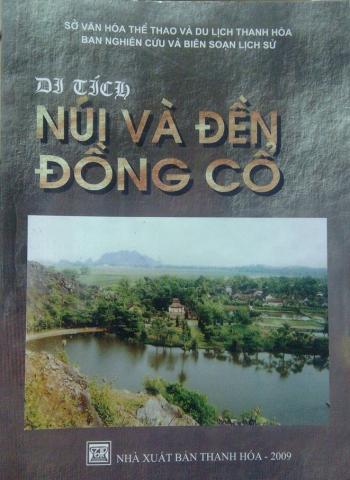 ác giả: Ban Nghiên cứu và biên soạn Lịch sử - Sở Văn hóa Thể thao và Du lịch Thanh Hóa
ác giả: Ban Nghiên cứu và biên soạn Lịch sử - Sở Văn hóa Thể thao và Du lịch Thanh Hóa
- Nxb: Thanh Hóa – 2009
- Khổ sách: 14,5 x 20,5cm
- Số trang: 104 tr
 ác giả: Ban Nghiên cứu và biên soạn Lịch sử - Sở Văn hóa Thể thao và Du lịch Thanh Hóa
ác giả: Ban Nghiên cứu và biên soạn Lịch sử - Sở Văn hóa Thể thao và Du lịch Thanh Hóa- Nxb: Thanh Hóa – 2009
- Khổ sách: 14,5 x 20,5cm
- Số trang: 104 tr
Cuốn sách giới thiệu về di tích núi và đền Đồng Cổ làng Đan Nê, xã Yên Thọ, huyện Yên Định, tỉnh Thanh Hóa, là một trong những danh thắng của xứ Thanh.
Năm 2007 Sở Văn hóa Thể thao và Du lịch Thanh Hóa đã tổ chức khai quật khảo cổ học một số địa điểm ở núi và đền Đồng Cổ để làm cơ sở khoa học phục vụ cho việc lập dự án bảo tồn tôn tạo di tích, đồng thời sưu tầm, khảo sát và phục dựng nghi lễ của Đền Đồng Cổ. Cuốn sách nêu kết quả của cuộc khai quật.
Cuốn sách gồm các phần: 1/ Một vùng thắng tích Đan Nê: giới thiệu cảnh quan danh thắng làng Đan Nê. 2/ Lịch sử thờ thần Đồng Cổ; 3/ Đền Đồng Cổ - qua khai quật khảo cổ học; 4/ Bài trí đồ thờ; 5/ Nghi thức lễ tế.
Xin trân trọng giới thiệu!
Năm 2007 Sở Văn hóa Thể thao và Du lịch Thanh Hóa đã tổ chức khai quật khảo cổ học một số địa điểm ở núi và đền Đồng Cổ để làm cơ sở khoa học phục vụ cho việc lập dự án bảo tồn tôn tạo di tích, đồng thời sưu tầm, khảo sát và phục dựng nghi lễ của Đền Đồng Cổ. Cuốn sách nêu kết quả của cuộc khai quật.
Cuốn sách gồm các phần: 1/ Một vùng thắng tích Đan Nê: giới thiệu cảnh quan danh thắng làng Đan Nê. 2/ Lịch sử thờ thần Đồng Cổ; 3/ Đền Đồng Cổ - qua khai quật khảo cổ học; 4/ Bài trí đồ thờ; 5/ Nghi thức lễ tế.
Xin trân trọng giới thiệu!
Ngô Thị Nhung
- Tác giả: N guyễn Anh Huy
guyễn Anh Huy
- Nxb: Hà Nội – 2013
- Khổ sách: 14,5x 20,5cm
- Số trang: 509 trang + phụ lục ảnh
Nội dung cuốn sách: Cuốn sách giới thiệu về lịch sử tiền tệ Việt Nam và Đông Á, thực trạng nghiên cứu tiền hiện nay và giới thiệu sưu tập tiền của một số thời kỳ theo tiến trình lịch sử, bao gồm các phần:1/ Những vấn đề lý luận: sự hình thành tiền tệ, vì sao có quyển sách này, quá trình nghiên cứu tiền cổ Việt Nam và những giới hạn, nền tảng của phương pháp nghiên cứu; 2/ Khảo luận: giới thiệu tiền từ thời Lý đến thời Nguyễn; 3/ Những vấn đề liên quan.
Xin trân trọng giới thiệu!
 guyễn Anh Huy
guyễn Anh Huy- Nxb: Hà Nội – 2013
- Khổ sách: 14,5x 20,5cm
- Số trang: 509 trang + phụ lục ảnh
Nội dung cuốn sách: Cuốn sách giới thiệu về lịch sử tiền tệ Việt Nam và Đông Á, thực trạng nghiên cứu tiền hiện nay và giới thiệu sưu tập tiền của một số thời kỳ theo tiến trình lịch sử, bao gồm các phần:1/ Những vấn đề lý luận: sự hình thành tiền tệ, vì sao có quyển sách này, quá trình nghiên cứu tiền cổ Việt Nam và những giới hạn, nền tảng của phương pháp nghiên cứu; 2/ Khảo luận: giới thiệu tiền từ thời Lý đến thời Nguyễn; 3/ Những vấn đề liên quan.
Ngô Thị Nhung
- Tác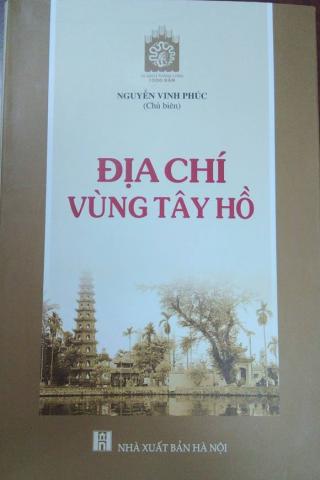 giả: Nguyễn Vinh Phúc
giả: Nguyễn Vinh Phúc
- Nxb: Hà Nội – 2017
- Khổ sách: 16 x 24cm
- Số trang: 1099 tr
Nội dung cuốn sách: Trên mảnh đất Thăng Long – Hà Nội, vùng đất Tây Hồ có vị trí đặc biệt quan trọng, là trung tâm về mặt cảnh quan, tâm linh của Thăng Long – Hà Nội xưa và nay. Trên địa bàn quận Tây Hồ có tới 66 di tích lịch sử, kiến trúc nghệ thuật và cách mạng, kháng chiến, trong đó có 37 di tích đã được xếp hạng cấp quốc gia và thành phố (số liệu thống kê năm 2015).
Cuốn sách là kết quả của quá trình thu thập tài liệu, tích lũy, chắt lọc, phân tích, tổng hợp một khối lượng thông tin phong phú, đa dạng về các khía cạnh khác nhau của vùng Tây Hồ. Qua Cuốn sách, người đọc có một cái nhìn tương đối toàn diện về mảnh đất và con người vùng Tây Hồ trong không gian Thủ đô Hà Nội. Cuốn sách là điểm nhấn cho việc xây dựng địa chí vùng, cũng chính là viên gạch nền xây lên bộ địa chí về Thăng Long – Hà Nội trong tương lai không xa.
Nội dung gồm 8 phần: 1/ Nêu điều kiện tự nhiên, lịch sử hình thành vùng đất Tây Hồ; 2/Hồ Tây – Hồ Trúc Bạch – Kẻ Bưởi và sông Thiên Phù; 3/Cư dân – lịch sử, 4/ Kinh tế; 5/ Văn hóa – nghệ thuật; 6/Di tích lịch sử văn hóa, cách mạng kháng chiến; 7/Văn học; 8/ Giáo dục và y tế; 9/ Quy hoạch vùng Tây Hồ; 10/ Các làng cũ ven hồ
Xin trân trọng giới thiệu!
 giả: Nguyễn Vinh Phúc
giả: Nguyễn Vinh Phúc- Nxb: Hà Nội – 2017
- Khổ sách: 16 x 24cm
- Số trang: 1099 tr
Nội dung cuốn sách: Trên mảnh đất Thăng Long – Hà Nội, vùng đất Tây Hồ có vị trí đặc biệt quan trọng, là trung tâm về mặt cảnh quan, tâm linh của Thăng Long – Hà Nội xưa và nay. Trên địa bàn quận Tây Hồ có tới 66 di tích lịch sử, kiến trúc nghệ thuật và cách mạng, kháng chiến, trong đó có 37 di tích đã được xếp hạng cấp quốc gia và thành phố (số liệu thống kê năm 2015).
Cuốn sách là kết quả của quá trình thu thập tài liệu, tích lũy, chắt lọc, phân tích, tổng hợp một khối lượng thông tin phong phú, đa dạng về các khía cạnh khác nhau của vùng Tây Hồ. Qua Cuốn sách, người đọc có một cái nhìn tương đối toàn diện về mảnh đất và con người vùng Tây Hồ trong không gian Thủ đô Hà Nội. Cuốn sách là điểm nhấn cho việc xây dựng địa chí vùng, cũng chính là viên gạch nền xây lên bộ địa chí về Thăng Long – Hà Nội trong tương lai không xa.
Nội dung gồm 8 phần: 1/ Nêu điều kiện tự nhiên, lịch sử hình thành vùng đất Tây Hồ; 2/Hồ Tây – Hồ Trúc Bạch – Kẻ Bưởi và sông Thiên Phù; 3/Cư dân – lịch sử, 4/ Kinh tế; 5/ Văn hóa – nghệ thuật; 6/Di tích lịch sử văn hóa, cách mạng kháng chiến; 7/Văn học; 8/ Giáo dục và y tế; 9/ Quy hoạch vùng Tây Hồ; 10/ Các làng cũ ven hồ
Ngô Thị Nhung
Trân trọng kính mời Quý Thầy, Cô, các Nhà nghiên cứu, Nghiên cứu sinh, Học viên Cao học, Sinh viên và mọi người có quan tâm tới dự buổi tọa đàm khoa học với hai chủ đề: “Một số nhận thức mới về văn hóa Bắc Sơn”.
Người trình bày: PGS.TS Trình Năng Chung và TS. Nguyễn Trường Đông (Viện Khảo cổ học).
Thời gian: 9h00, thứ năm ngày 30 tháng 8 năm 2018.
Địa điểm: Hội trường, Viện Khảo cổ học, 61 Phan Chu Trinh, Hà Nội.
Rất hân hạnh được đón tiếp!
Người trình bày: PGS.TS Trình Năng Chung và TS. Nguyễn Trường Đông (Viện Khảo cổ học).
Thời gian: 9h00, thứ năm ngày 30 tháng 8 năm 2018.
Địa điểm: Hội trường, Viện Khảo cổ học, 61 Phan Chu Trinh, Hà Nội.
Rất hân hạnh được đón tiếp!
Viện Khảo cổ học ban hành Quyết định số 177/QĐ- KCH ngày 9 tháng 7 năm 2018 về việc phê duyệt kế hoạch lựa chọn nhà thầu phục vụ Hội thảo thông báo Khảo cổ học năm 2018: Những phát hiện mới về Khảo cổ học toàn quốc lần thứ 53.
Phòng Tổ chức Hành chính, Phòng QLKH-KHTC-HTQT và ban tổ chức hội thảo chịu trách nhiệm tổ chức lựa chọn nhà thầu, giám sát, theo dõi hoạt động đấu thầu theo kế hoạch được duyệt đảm bảo tuân thủ các quy định hiện hành của Nhà nước.
Phòng Tổ chức Hành chính, Phòng QLKH-KHTC-HTQT và ban tổ chức hội thảo chịu trách nhiệm tổ chức lựa chọn nhà thầu, giám sát, theo dõi hoạt động đấu thầu theo kế hoạch được duyệt đảm bảo tuân thủ các quy định hiện hành của Nhà nước.
Viện Khảo cổ học ban hành Quyết định số 175/QĐ- KCH ngày 6 tháng 7 năm 2018 về việc lựa chọn nhà thầu phục vụ hội thảo khoa học Đại hội lần thứ 21 hội khoa học Tiền sử Ấn Độ - Thái Bình Dương (IPPA) năm 2018 (nội dung chi tiết theo phụ lục đính kèm).
Phòng Tổ chức Hành chính, Phòng QLKH-KHTC-HTQT và ban tổ chức hội thảo chịu trách nhiệm tổ chức lựa chọn nhà thầu, giám sát, theo dõi hoạt động đấu thầu theo kế hoạch được duyệt đảm bảo tuân thủ các quy định hiện hành của Nhà nước.
Phòng Tổ chức Hành chính, Phòng QLKH-KHTC-HTQT và ban tổ chức hội thảo chịu trách nhiệm tổ chức lựa chọn nhà thầu, giám sát, theo dõi hoạt động đấu thầu theo kế hoạch được duyệt đảm bảo tuân thủ các quy định hiện hành của Nhà nước.
Quyết định về việc phê duyệt kế hoạch lựa chọn nhà thầu trong công tác chống xuống cấp năm 2018 của Viện Khảo cổ học.
Viện Hàn lâm Khoa học Xã hội Việt Nam ban hành Quyết định số 604/QĐ- KHXH ngày 23 tháng 4 năm 2018 về việc phê duyệt kế hoạch lựa chọn nhà thầu trong công tác chống xuống cấp năm 2018 của Viện Khảo cổ học.
Căn cứ vào các Nghị định và thông tư (File đính kèm)
QUYẾT ĐỊNH
Điều 1: Phê duyệt kế hoạch lựa chọn nhà thầu cho hạng mục xuống cấp năm 2018 của Viện Khảo cổ học với nội dung như sau:
Nội dung kế hoạch lựa chọn nhà thầu: (File đính kèm)
Điều 2: Chủ đầu tư Viện Khảo cổ học có trách nhiệm triển khai các bước tiếp theo đúng quy định của Nhà nước Việt Nam về công tác đầu tư xây dựng và quyết định số 1823/QĐ-KHXH ngày 1/9/2016 quy định quản lý hoạt động nhỏ, sửa chữa lớn của Viện Hàn lâm Khoa học Xã hội Việt Nam.
Điều 3: Các ông, (bà) Chánh Văn phòng, Trưởng Ban kế hoạch - Tài chính, chủ đầu tư Viện Khảo cổ học và các đơn vị có liên quan chịu trách nhiệm thi hành quyết định này.
KT. Chủ tịch
Phó Chủ tịch
Bùi Nhật Quang (Đã ký)
Phó Chủ tịch
Bùi Nhật Quang (Đã ký)
Hộ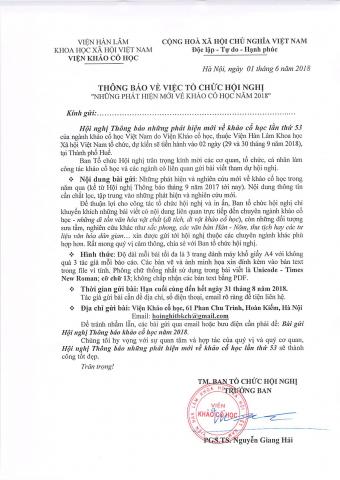 i nghị Thông báo những phát hiện mới về Khảo cổ học lần thứ 53 năm 2018 của ngành Khảo cổ học Việt Nam do Viện Khảo cổ học, thuộc Viện Hàn lâm Khoa học xã hội Việt Nam tổ chức, dự kiến sẽ tiến hành vào 02 ngày (29 và 30 tháng 9 năm 2018), tại thành phố Huế.
i nghị Thông báo những phát hiện mới về Khảo cổ học lần thứ 53 năm 2018 của ngành Khảo cổ học Việt Nam do Viện Khảo cổ học, thuộc Viện Hàn lâm Khoa học xã hội Việt Nam tổ chức, dự kiến sẽ tiến hành vào 02 ngày (29 và 30 tháng 9 năm 2018), tại thành phố Huế.
 i nghị Thông báo những phát hiện mới về Khảo cổ học lần thứ 53 năm 2018 của ngành Khảo cổ học Việt Nam do Viện Khảo cổ học, thuộc Viện Hàn lâm Khoa học xã hội Việt Nam tổ chức, dự kiến sẽ tiến hành vào 02 ngày (29 và 30 tháng 9 năm 2018), tại thành phố Huế.
i nghị Thông báo những phát hiện mới về Khảo cổ học lần thứ 53 năm 2018 của ngành Khảo cổ học Việt Nam do Viện Khảo cổ học, thuộc Viện Hàn lâm Khoa học xã hội Việt Nam tổ chức, dự kiến sẽ tiến hành vào 02 ngày (29 và 30 tháng 9 năm 2018), tại thành phố Huế.Vậy Ban Tổ chức Hội nghị trân trọng kính mời các cơ quan, tổ chức, cá nhân làm công tác khảo cổ học và các ngành có liên quan gửi bài viết tham dự Hội nghị.
- Thời gian gửi bài: Hạn cuối cùng đến hết ngày 31 tháng 8 năm 2018
- Địa chỉ gửi bài: Viện Khảo cổ học, 61 Phan Chu Trinh, Hoàn Kiếm, Hà Nội
Thư điện tử Email: hoinghitbkch@gmail.com
- Nội dung, thể lệ và hình thức bài gửi xin xem file đính kèm bên cạnh.
Thư điện tử Email: hoinghitbkch@gmail.com
- Nội dung, thể lệ và hình thức bài gửi xin xem file đính kèm bên cạnh.
Viện Khảo cổ học xin trân trọng thông báo!
TM. Ban Tổ chức Hội nghị
Viện Trưởng
Nguyễn Giang Hải đã ký.
TM. Ban Tổ chức Hội nghị
Viện Trưởng
Nguyễn Giang Hải đã ký.
- Tác giả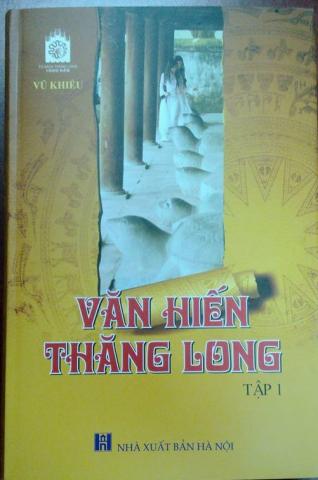 : Vũ Khiêu
: Vũ Khiêu
- Nxb: Hà Nội – 2017
- Khổ sách: 16 x 24cm
- Số trang: 815 tr
 : Vũ Khiêu
: Vũ Khiêu- Nxb: Hà Nội – 2017
- Khổ sách: 16 x 24cm
- Số trang: 815 tr
Đây không phải là bộ sách lịch sử mà là bộ sách bàn về sự vận động của Văn hiến Thăng Long qua các thời kỳ. Mỗi thời kỳ trước hết đều xuất phát từ những đặc trưng của văn hiến và tác động qua lại giữa các đặc trưng ấy với diễn biến của lịch sử như thế nào ? Mỗi sự kiện lịch sử đưa vào quyển sách chỉ tồn tại khi nó gắn bó với sự phát triển của văn hiến.
Mỗi thời kỳ lịch sử phải nói lên được sự vận động của bốn đặc điểm chủ yếu của Văn hiến Thăng Long. Nhân tố thứ nhất là tình thương, nhân tố thứ hai là trí tuệ, nhân tố thứ ba là anh hùng, nhân tố thứ tư là hòa bình và hữu nghị.
Bộ sách Văn hiến Thăng Long chính là bộ sách trình bày sự vận động của bốn nhân tố nói trên trong lịch sử dân tộc. Thực hiện được cả 4 yếu tố đó thì thành công, bỏ đi một vài yếu tố không tránh khỏi sự suy yếu.
Nội dung gồm 3 phần: 1/ Văn hiến Thăng Long – định nghĩa và nội dung; 2/ Văn hiến Thăng Long qua thời kỳ văn lang – âu lạc và dưới thời bắc thuộc; 3/ Văn hiến Thăng Long qua 8 thế kỷ (1010 – 1802) tại thủ đô mang tên Thăng Long.
Mỗi thời kỳ lịch sử phải nói lên được sự vận động của bốn đặc điểm chủ yếu của Văn hiến Thăng Long. Nhân tố thứ nhất là tình thương, nhân tố thứ hai là trí tuệ, nhân tố thứ ba là anh hùng, nhân tố thứ tư là hòa bình và hữu nghị.
Bộ sách Văn hiến Thăng Long chính là bộ sách trình bày sự vận động của bốn nhân tố nói trên trong lịch sử dân tộc. Thực hiện được cả 4 yếu tố đó thì thành công, bỏ đi một vài yếu tố không tránh khỏi sự suy yếu.
Nội dung gồm 3 phần: 1/ Văn hiến Thăng Long – định nghĩa và nội dung; 2/ Văn hiến Thăng Long qua thời kỳ văn lang – âu lạc và dưới thời bắc thuộc; 3/ Văn hiến Thăng Long qua 8 thế kỷ (1010 – 1802) tại thủ đô mang tên Thăng Long.
Xin trân trọng giới thiệu!
Ngô Thị Nhung
Trang
Copyright © 2016 by khaocohoc.gov.vn.
Thiết kế bởi VINNO
Tổng số lượt truy cập: 10406088
Số người đang online: 19

